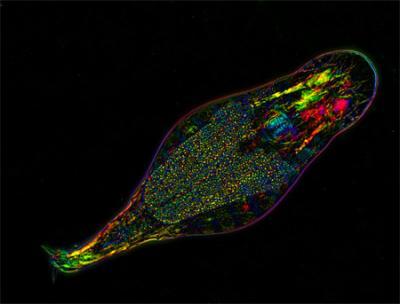Adineta vaga, the delloid rotifer, abandoned sex yet still produced more than 460 species over evolutionary time.
Rather than the standard way of using sexual reproduction to weed out harmful mutations to its DNA, this tiny aquatic animal appears to have adopted other strategies to maintain lineages over millennia that aren't burdened by genetic damage or killed off altogether.
Neither males nor meiosis (cell division to produce sperm or eggs) have ever been observed in a bdelloid rotifer. Instead, the unfertilized eggs just divide to produce offspring. This reproductive strategy, which for most animals would be an evolutionary dead end, is borne out by the rotifer's genome, the structure of which "is completely consistent with what you would expect to see with a long-term absence of meiosis," says co-author Mark Welch of the Marine Biological Laboratory, Woods Hole, Massachusetts. "It's hard to prove a negative, and we can never say there is no chance the rotifer is ever having sex. But it would have to be some kind of crazy meiosis."
In most animal species, alternative forms of the same gene (alleles) are found in the same spot on two different chromosomes—one from the mother, one from the father—which pair during meiosis, and segregate into new sperm and egg cells. In the bdelloid genome, gene copies either don't match up positionally along chromosome pairs or are located on the same chromosome. This means the alleles would not be able to pair up normally during meiosis and segregate evenly into new sperm and egg cells.

Genes are represented with letters, and dashed lines connect allelic gene pairs. A meiotic genome (left) alternates between a haploid phase (in which a single allele of each gene is present) and a diploid phase (in which the genes are present in two allelic versions arranged colinearly on homologous chromosomes). In the ameiotic genome of A. vaga (right), alleles are distributed in blocks that are shuffled across chromosomes, resulting notably in intrachromosomal repeats (direct or inverted). As a consequence, chromosomes have no homologues and cannot be paired. Credit and link:
doi:10.1038/nature12326
If bdelloids are not having sex, how can they avoid the accumulation of deleterious mutations or generate new diversity? The bdelloid genome shows evidence for other ways of maintaining healthy genes and viable lineages. One is gene conversion, in which one allele replaces another through DNA repair mechanisms or other strategies. The other is horizontal gene transfer (HGT), the transfer of DNA from one organism to another, which is common among microbes yet rarely seen in animals. At least 8 percent of the rotifer's genes, more than in any other animal, are likely to have been acquired by HGT.

This shows the bdelloid rotifer Adineta vaga, birefringence image, polarized light microscope. Credit: M. Shribak and I. Arkhipova, MBL
"In general, animal germ lines are fairly well protected from acquiring DNA from external sources," says co-author Irina Arkhipova, also of Woods Hole. Bdelloids are unusual, though, in that they can completely dry up (desiccate) for weeks or months at a time, and then spring back to life when water becomes available. During their desiccation phases, their DNA breaks up into many pieces. "When they rehydrate, this might be an opportunity for foreign DNA fragments from ingested bacteria, fungi, or microalgae to transfer into the rotifer genome," Arkhipova says.
More significantly, this may also be a chance for the rotifer to incorporate genes from other rotifers. This would be quite useful if it needed to pick up genes to repair damaged ones through gene conversion, the authors suggest. "In this way, the processes of mutation and DNA repair mimic some aspects of sex," Welch says.
Another striking finding in the bdelloid rotifer genome was the extremely low number of transposons, "pieces of DNA sometimes called 'genetic parasites' that are capable of moving around the genome and causing harmful mutations," Arkhipova says. While about 50 percent of the mammalian genome is transposons, they constitute only about 3 percent of the bdelloid genome, "and their proliferative capacity appears to be severely limited," Arkhipova says. This affords the rotifer a layer of protection from mutations that most animals don't enjoy. "We are interested in dissecting this multi-layered genome defense system in our future studies," she says.
Citation: Jean-François Flot, Boris Hespeels, Xiang Li, Benjamin Noel, Irina Arkhipova, Etienne G. J. Danchin, Andreas Hejnol, Bernard Henrissat, Romain Koszul, Jean-Marc Aury, Valérie Barbe, Roxane-Marie Barthélémy, Jens Bast, Georgii A. Bazykin, Olivier Chabrol, Arnaud Couloux, Martine Da Rocha, Corinne Da Silva, Eugene Gladyshev, Philippe Gouret, Oskar Hallatschek, Bette Hecox-Lea, Karine Labadie, Benjamin Lejeune, Oliver Piskurek, Julie Poulain, Fernando Rodriguez, Joseph F. Ryan, Olga A. Vakhrusheva, Eric Wajnberg, Bénédicte Wirth, Irina Yushenova, Manolis Kellis, Alexey S. Kondrashov, David B. Mark Welch, Pierre Pontarotti, Jean Weissenbach, Patrick Wincker, Olivier Jaillon&Karine Van Doninck,'Genomic evidence for ameiotic evolution in the bdelloid rotifer Adineta vaga', Nature (2013) doi:10.1038/nature12326




Comments